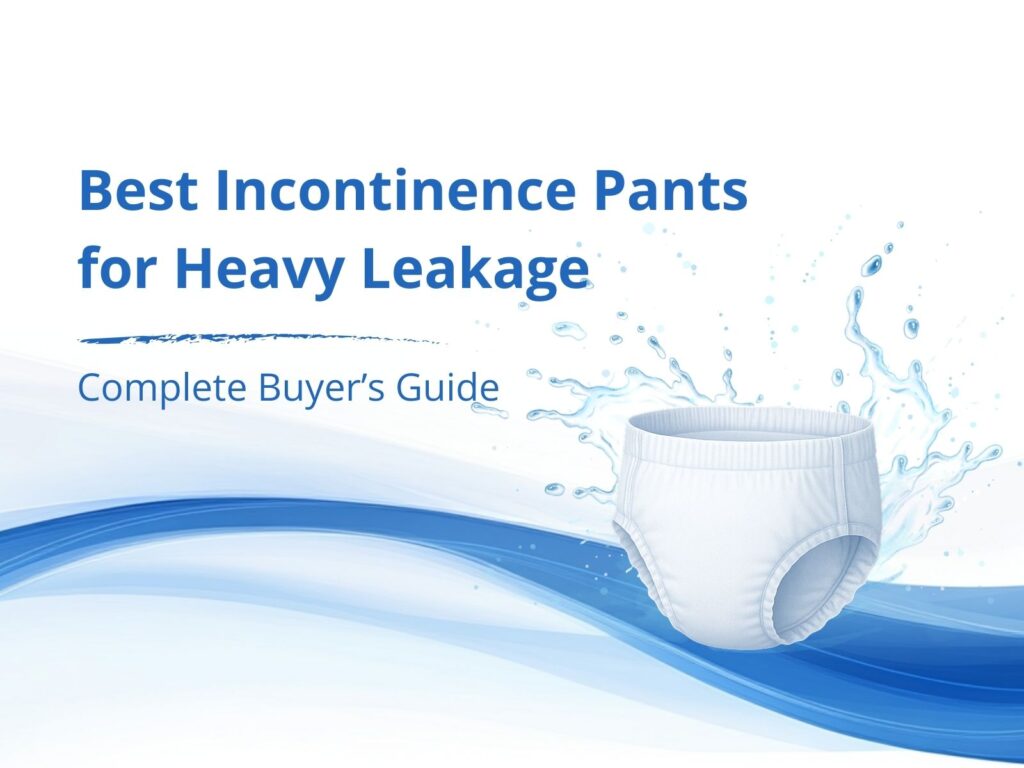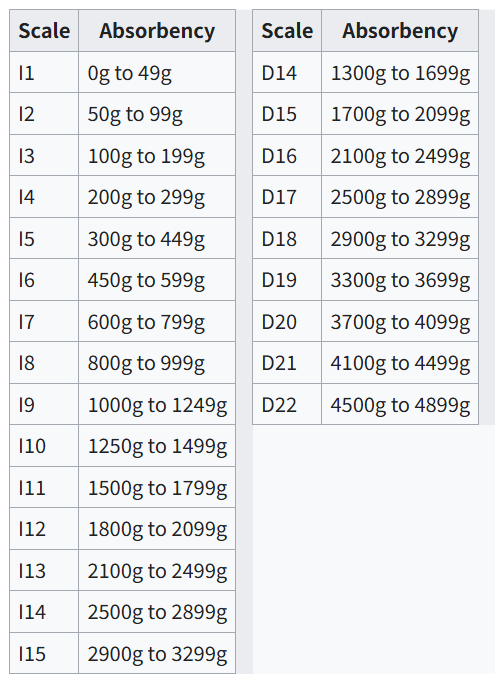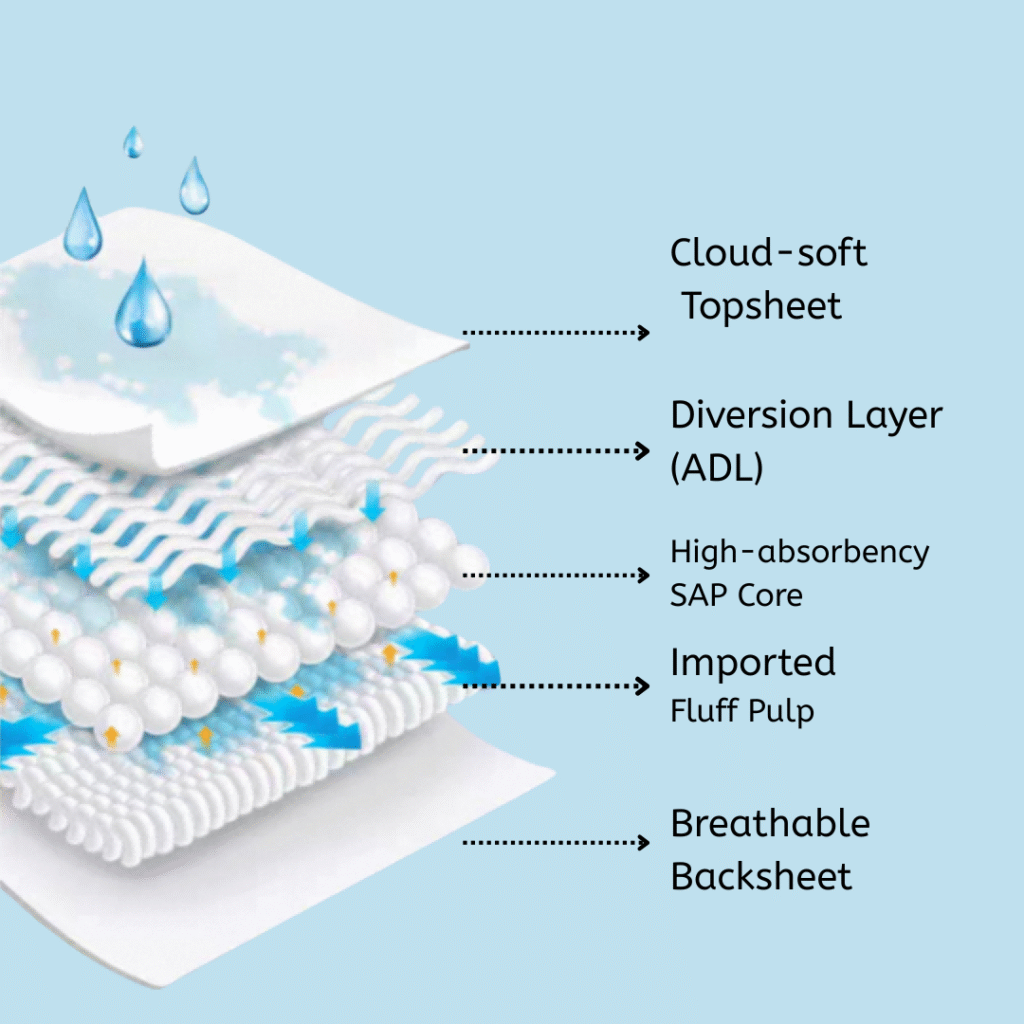
Finding the best incontinence pants for heavy leakage isn’t just about chasing labels like “ultra” or “extra.” It’s about understanding the science behind absorbency, how product structures work, and how real-life usage affects performance. Whether you’re a healthcare buyer sourcing in bulk, a nursing home director, or an individual end user, making the right choice can significantly improve daily comfort, dignity, and quality of life.
This comprehensive guide breaks down the key metrics, materials, and structural elements that determine performance, and shows you how to match the product to the user’s actual needs.
Quick Answer: What Are the Best Incontinence Pants for Heavy Leakage?
If you’re short on time and looking for a checklist, here’s a quick snapshot of what defines the best incontinence pants for heavy leakage:
ISO-tested absorbency of at least 1800ml under the ISO 11948-1 (ROSA) standard
Premium SAP (Super Absorbent Polymer) sourced from Japan or Germany
Balanced SAP-to-Fluff ratio for both structure and capacity (typically 70:30)
Advanced ADL (Acquisition Distribution Layer) to speed up absorption and prevent pooling
Dual leak guards and breathable backsheet for prolonged wear, especially at night
Flexible, adaptive fit suitable for various body types, genders, and mobility levels
With that overview in mind, let’s take a deeper look at the science and design behind these features—and how to verify them.
What Does “Heavy Leakage” Really Mean?
To evaluate whether an incontinence pant is suitable for heavy leakage, you must first understand what “heavy” truly implies in clinical and practical terms.
A healthy adult typically urinates 200–400ml per void, and someone with severe incontinence may experience 6–8 episodes a day. This means total daily urinary output can range from 1500ml to 2500ml, not including additional challenges like fecal incontinence.
Thus, a product intended for heavy leakage must be capable of absorbing at least 1800ml under pressure while minimizing rewetting and leakage during prolonged use—especially when the user is sleeping or seated for long periods.
How Absorbency Is Measured: ISO 11948-1 and the Rothwell Scale
Once you understand the volume challenge, the next step is to look at how absorbency is quantified and verified.
The ISO 11948-1:1996 (ROSA) test is the industry standard for measuring the total absorbency of incontinence products under controlled laboratory conditions. This test determines how much liquid a product can hold before leakage or rewetting occurs.
Building on this standard, the Rothwell Scale offers a practical coding system for classifying absorbency performance:
Each level on the Rothwell Scale corresponds to a measured absorbency range in grams, with higher codes indicating greater capacity. The prefix “I” refers to inserts and liners, while “D” applies to all-in-one products like pull-ups and tape-on diapers.
| Rothwell Code | Absorbency (g) | Product Type |
|---|---|---|
| I1–I13 | 0–2499g | Pads, liners, inserts |
| D14–D22 | 1300–4899g | Pull-ups, taped diapers |

Each level on the Rothwell Scale corresponds to a measured absorbency range in grams, with higher codes indicating greater capacity. The prefix “I” refers to inserts and liners, while “D” applies to all-in-one products like pull-ups and tape-on diapers.
If a manufacturer can provide certified test results showing that their product achieves a Rothwell D-level rating (e.g., D16, D20, or D22), this serves as concrete proof that the product can reliably handle heavy leakage. For high-need users, a higher D-rating means longer wear time and fewer changes, which is especially important for nighttime use or users with reduced mobility.
Icon systems
Many packaging use 💧icons, but these are non-standardized. For serious buyers, Rothwell/ISO data in grams is the most dependable benchmark.
Inside the Structure: 6 Functional Layers of Incontinence Pants
With absorbency defined, let’s explore how incontinence pants are constructed to manage that liquid effectively.
High-quality pull-up pants typically consist of six coordinated layers, each designed for a specific function:

| Layer | Function |
|---|---|
| Cloud-soft Topsheet | Ultra-soft and skin-friendly; quickly transfers moisture away to keep the surface dry. |
| Diversion Layer (ADL) | Distributes fluid evenly across the surface, preventing pooling and speeding up absorption. |
| SAP Core | Locks fluid into gel with high-performance Super Absorbent Polymer, minimizing rewetting. |
| Fluff Pulp | Provides structural support to the SAP core and absorbs residual moisture. |
| Breathable Backsheet | Waterproof yet breathable layer that keeps the skin dry and reduces heat buildup. |
| Elastic Pants Shell | Snug, body-contouring outer shell that prevents side leaks during movement or sleep. |
Each layer plays a role, but it is the SAP Core that provides the greatest contribution to total absorbency. Still, the performance of SAP depends heavily on the surrounding layers to function properly.
Each layer plays a role, but it is the SAP Core that provides the greatest contribution to total absorbency. Still, the performance of SAP depends heavily on the surrounding layers to function properly.
Understanding SAP: The Core of Heavy-Duty Protection
Super Absorbent Polymer (SAP) is the key ingredient that gives incontinence pants their fluid retention power. However, not all SAP is created equal.
High-performance SAP offers fast gel formation and strong moisture retention without rewetting
Imported SAP from Japan or Germany is known for its higher retention power and purity compared to local alternatives
SAP must be evenly distributed within the core to prevent saturation hotspots or channeling
At Glory, we use premium-grade SAP with up to 3× the absorbency and retention of standard domestic SAP. This ensures optimal dryness and performance even under heavy loads.
Why SAP Needs Fluff: The Ideal Absorbency Ratio
While SAP handles the bulk of fluid absorption, it cannot perform alone. That’s where fluff pulp comes in.
Too much SAP without adequate fluff can cause the core to collapse, shift, or clump—leading to leakage. A balanced ratio, typically around 70:30 (SAP:Fluff), ensures structural integrity and even fluid distribution. This combination allows the pants to retain large volumes while remaining soft, stable, and comfortable.
Instant vs Total Absorption: Why Speed Matters
Absorbency is not just about total volume—speed also matters. Even if a pant can hold 2000ml, it must react quickly to sudden releases to prevent surface wetness or overflow.
Key metrics include:
Instant Absorption Speed: The time it takes to pull fluid away from the skin (ideal: <5 seconds)
Total Absorption Capacity: How much fluid can be locked in without leaking or rewetting
The ADL layer is essential for improving this speed, guiding liquid toward the SAP core efficiently.
Night-Time Protection: Built for Long Hours
Overnight leakage poses a particularly tough challenge, as users may not be able to change products frequently. A well-designed night-use pant incorporates:
Dual SAP zones (front and back) for even distribution
High side leak guards for lateral protection
Extra length or rear padding to support lying positions
Soft, breathable backsheet for long-term comfort
These features are vital for caregivers managing immobile or bedridden patients.
Gender & Body-Specific Designs
While many incontinence pants are labeled unisex, leading manufacturers understand the value of fit optimization based on anatomy.
Men may need more absorbency in the front panel
Women often require better coverage in the mid-front and crotch area
Bariatric users benefit from more elastic stretch and leg openings
Bedridden users need enhanced absorbency toward the rear
Glory’s OEM program supports custom SAP placement and sizing to better match specific demographic and clinical needs.
While pants offer a versatile, full-coverage solution, other incontinence products like pads, liners, guards, or taped diapers may be more suitable in certain situations—depending on mobility level, leakage severity, or ease of changing.
Important Reminder: Lab Data ≠ Real-Life Use
Although ISO 11948-1 provides a critical benchmark, it’s vital to remember that these tests are conducted in ideal conditions. In practice, performance may vary due to:
Body position and movement (lying, walking, sitting)
Frequency and volume of urination
Time between changes
Skin temperature and contact pressure
A pant rated for 2500ml in lab conditions may handle only 1800ml in real-world use.
That’s why lab data should be viewed as a baseline, and actual product testing should always be done to evaluate fit, comfort, and reliability for specific user scenarios.
Final Tips: How to Choose the Best Incontinence Pants
To summarize, here are the key factors to assess before purchasing:
Check ISO 11948-1 or Rothwell absorbency level (D16 or above for heavy use)
Confirm SAP source and amount per piece (preferably Japan or Germany origin)
Evaluate SAP-to-Fluff ratio (70:30 preferred)
Look for instant-absorbing ADL design
Ensure fit matches user profile (gender, size, mobility)
Request lab data and samples before bulk ordering
Why Choose Glory?
Customizable Absorbency – Whether you need 1500ml or 4500ml+, we tailor the capacity based on ISO-certified benchmarks
3× Higher SAP Retention – Premium Japan-imported SAP for faster, deeper locking
Customizable Structure – Tailored ADL, SAP content, and SAP:Fluff ratio per your use case
Overnight-Grade Protection – Dual-core SAP zones, extended length, and leak guards available
Anatomy-Adaptive Fit – Designs available for male, female, bariatric, and bedridden users
Instant Absorption Speed – ADL tech ensures dryness within 3–5 seconds
OEM Support – Private label, packaging, sizing, and branding services available
Looking for a trusted OEM manufacturer of high-performance adult pants for heavy leakage? Contact Glory today for samples, test reports, and a custom solution designed for your incontinence care needs.


